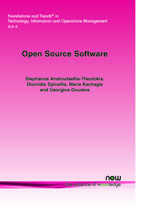Open Source Software: A Survey from 10,000 Feet
By Stephanos Androutsellis-Theotokis, Department of Management Science and Technology, Athens University of Economics and Business, Greece, stheotok@aueb.gr | Diomidis Spinellis, Department of Management Science and Technology, Athens University of Economics and Business, Greece, dds@aueb.gr | Maria Kechagia, Department of Management Science and Technology, Athens University of Economics and Business, Greece, mkehagia@dmst.aueb.gr | Georgios Gousios, Department of Management Science and Technology, Athens University of Economics and Business, Greece, gousiosg@aueb.gr
Abstract
Open source software (oss), the origins of which can be traced back to the 1950s, is software distributed with a license that allows access to its source code, free redistribution, the creation of derived works, and unrestricted use. oss applications cover most areas of consumer and business software and their study touches many disciplines, including computer science, information systems, economics, psychology, and law. Behind a successful oss project lies a community of actors, ranging from core developers to passive users, held together by a flexible governance structure and membership, leadership and contribution policies that align their interests. The motivation behind individuals participating in oss projects can be, among others, social, ideological, hedonistic, or signaling, while companies gain from their access to high-quality, innovative projects and an increase in their reputation and visibility. Nowadays many business models rely on oss as a product through the provision of associated services, or in coexistence with proprietary software, hardware, services, or licensing. The numerous oss licenses mainly differ on how they treat derived software: some contain provisions that maintain its availability in open source form while others allow more flexibility. Through its widespread adoption, oss is affecting the software industry, science, engineering, research, teaching, the developing countries, and the society at large through its ability to democratize technology and innovation.
Open Source Software
Open Source Software: A Survey from 10,000 Feet provides an overview of the history, development, and applications of open source software (OSS). OSS is software distributed with a license allowing access to its source code, free redistribution, the creation of derived works, and unrestricted use. The history of open source software can be traced back to the 1950s. Open source applications cover most areas of consumer and business software. The organization of open source development projects often differs from proprietary ones in terms of their organizational structure, membership, leadership, contribution policies and quality control. Behind a successful OSS project is its community, ranging from core developers to passive users. The key defining element of open source software is its license, which must satisfy a list of important requirements. There are numerous open source licenses, and they mainly differ in how they treat derived software: some contain provisions that maintain its availability in open source form, while others allow more flexibility. The emergence of open source software is fueling the economy as a whole through its widespread adoption as a cheap alternative to pricey proprietary products and as a driver behind many successful e-business ventures. Open source is also directly affecting specific sectors: the software development industry through competition and new business opportunities; hardware development through lower cost and barriers of entry, consumer-led innovation and policy enforcement difficulties; academia through valuable opportunities for research and student involvement in real-world applications, as well as the availability of software tools and the provision of pioneering new courses. It can lead to new design, production, marketing, and business models, as well as ways to develop large complex software systems in an organic manner. Challenges lie ahead, and problems still need to be overcome, so the potential for future research on OSS is large. More important however is the ability of open source development models to democratize technology and innovation.
